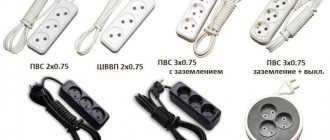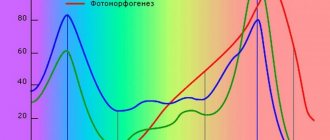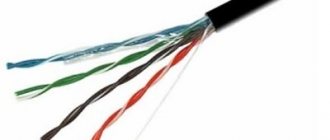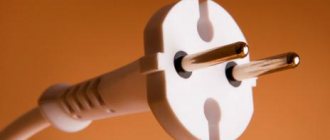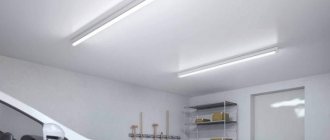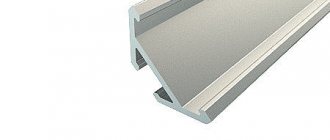An electricity meter performs many functions. It is very important to install it in a garage in order to distribute cables with different loads through different plugs, to constantly monitor energy consumption, and also to prevent any unforeseen situations due to energy surges. For example, the level of network security is significantly increased by installing a circuit breaker. Today we will find out which electricity meter is best to install in the garage. Let's take a closer look at what types of metering devices there are now, how they differ from each other, and what advantages and disadvantages they have.
Please note: it is better to install a modern electric meter in the garage. This is necessary not only to control energy consumption, but also to ensure a decent level of safety.
Selection options
Before you buy an electric meter for your garage, you should understand a little about the features of the devices in question. To do this you need:
- Calculate the maximum current consumption. If you do not plan to install energy-intensive equipment, then a device with a power of 10-50A will be enough for you. Otherwise, the electrical appliance must withstand a load of 100A.
- Find out the total number of phases. For example, the installation of metal-cutting units requires three-phase power.
- Take into account the accuracy class of the device. Usually it is 1.5-2%. Otherwise, the measuring equipment will not be accepted for operation by the regulatory authorities.
- Determine the characteristics of the device. Its price depends on additional features.
- Focus on installation requirements. Not all meters can be mounted on a DIN rail.
- Check the presence of the passport, guarantee and seals. They must be undamaged.
IMPORTANT: Before installing electrical equipment with maximum power, you need to know the parameters of the supply network. Such information can be clarified in the services servicing GSK
How to choose the right one
The choice of an electric meter depends on the characteristics of the network operation:
- single-phase induction - suitable for low energy consumption, usually only for lighting and switching on low-power consumers;
- three-phase electronic - if you plan to use machines and a welding unit. Such a device, as a rule, must be connected via a transformer;
In the latter case, the owner has the opportunity to take into account consumption according to several tariff plans.
Article on the topic: How to calculate square meters of a garage
You should also consider the temperature range of the device based on operating conditions. It is important to correctly determine the current characteristics of the meter and the power of the machine when turned on. It also depends on the total power of the connected devices.
Types of meters
To account for electricity consumption in non-residential premises, the following types of power plants are mainly used:
- Induction (electromechanical). Relatively inexpensive. Can work at low temperatures. The disadvantage is that they may have measurement errors.
- Electronic. Allows you to control the electricity consumed with the smallest errors. Not all device models can operate at low temperatures.
IMPORTANT: Modern electronic meters support work with communication modules, which allows you to take readings remotely
Three-phase meter for garage
In a garage where welding units and machines are often used, it would be logical to purchase a three-phase meter.
As a rule, such options are used in conditions where the rated power is more than 15 kW. They have many functions and are widely used in household networks and in monitoring three-phase electric motors.
The difference between such a device and a single-phase one is that it is capable of functioning under conditions of consuming large amounts of energy
There are several types of three-phase meters:
- Single tariff . It is considered standard; it has only one tariff and cannot be chosen. Suitable for installation in garages and production facilities.
- Two-tariff (multi-tariff). At night, the price per 1 kW of energy is significantly lower. This is beneficial for those who carry out activities in the garage at night, which significantly reduces electricity costs.
Three-phase meters come in two types:
- Electronic. The devices have a modern digital display.
- Mechanical. They include a screen with an arrow that shows the number of kW consumed.
The operating efficiency of both devices is at the same level. The differences may be in appearance or additional options, such as a remote control, but such models will cost significantly more.
Making a wiring diagram
To properly create a wiring diagram, make a list of electrical appliances that you plan to use in the garage. The number of lamps and their location must be taken into account.
If the garage is used only for parking and minor car repairs, then there is no need for a large number of sockets and lamps, but you also don’t need to save much. Above the workbench or near the entrance, you can install several sockets and a two-key switch so that you can divide the lighting lines into groups.
Article on the topic: Why in NFS carbon when you take a BMW in the garage the game crashes
A multi-use garage should have good lighting and plenty of conveniently located outlets. It is also necessary to ensure safe lighting of the inspection pit.
Design features
Different types of meters differ in design. The mechanical device consists of two coils: one is current, and the second is supplied with voltage. Inside them there is a metal disk mounted in sliding bearings. A worm pair is mounted on its axis, which is connected to a mechanical counter. When the device operates, an electromagnetic field arises, which causes the disk to rotate, due to which the amount of electricity consumed is calculated.
In electronic devices there is no mechanical part at all. These devices convert analog signals into digital ones. For this purpose, special pulse sensors are used, which are connected to electricity using a transformer. The signal is sent to the microcontroller, which allows you to calculate the energy consumed. This data is displayed on a digital display. Such devices have a high accuracy class and allow the accumulation and transmission of information through special communication channels.
Three-phase meters have a similar device. The most popular devices are electronic ones. Some models support single-phase metering. They are reliable, integrate into automated accounting systems, and are small in size.
Choosing an electric meter for the garage
The correct choice of electric meter for the garage is also of great importance. The number of tariffs, phases, as well as power and supply voltage differ. In addition, the mounting methods and accuracy class differ. Sometimes it is necessary to connect the device through a transformer, if the power consumption is high; professional equipment is often used in the garage when working in a workshop.
Types of meters
Electricity meters have two main types.
Electronic devices. Such devices solve all primary tasks and also have many additional functions and advantages. They attract with illumination, compactness, and increased accuracy. You can connect an electronic meter to a computer. The cost of such a device will depend on the set of additional options.
Induction models. These meters are still often preferred by garage workers. The devices are durable, provide a high level of reliability, and decent accuracy. At the same time, their prices are extremely affordable.
Meter design
Let's look at how different types of meters differ structurally.
Article on the topic: What Comrade Fetisov did for the sake of a car, film garage
Please note: together with the electric meter, modular elements, an RCD, and an input circuit breaker are installed. In electrical panels, special busbars must be installed to distribute grounding (PE) and zero N. In accordance with the wiring diagram, connecting them together is strictly prohibited, since the currents flow through them are different.
What is important to consider when choosing a meter
Remember which factors are most important when choosing a specific model of electric meter for your garage.
Connection method and accounting type
When choosing an electric meter, consumers pay attention not only to the operating principle, but also to the connection method and the type of metering for energy consumption. Three-phase devices are connected directly or indirectly.
The installation diagram is quite simple:
- When consuming a small amount of energy, install the device directly into the break in the supply wires.
- In the case of using powerful consumers, an indirect connection is used using intermediate transformers.
The type of device metering plays an important role in saving money if you use three-phase meters. During operation of such a device, active and reactive energy is consumed. If financial accounting is carried out with a single-phase electrical appliance, the active part is calculated. And when a multiphase unit operates, electricity is first consumed, then it is returned through the network. Energy metering can save money.
Purchasing consumables
Having drawn up a diagram, purchase everything you need to complete the work. We will do this thoroughly and for a long time, so we will consider installing hidden wiring. To be fair, there are other ways to run wires in the garage, which you can read about here.
In order not to waste precious time and effort in vain, purchase or rent a wall chaser and a hammer drill with a set of drills and a concrete bit, the diameter of which will allow you to install socket boxes and distribution boxes in the holes cut with it. We won’t even talk about a chisel and a hammer, since such a tool should be in any garage.
Article on the topic: How to make a pool in the garage
For further work you will need:
- Distribution panel – 1 pc.
- Electricity meter – 1 pc. (if needed).
- RCD – 1 pc.
- Socket boxes - according to the number of mortise switches and sockets.
- Distribution boxes - in each place where there will be a outlet for sockets and switches.
- Automatic switches - type and quantity according to the diagram. It may be necessary to install some machines separately, for example, near a grinding machine, compressor, etc.
- Wiring. It is better to purchase a copper three-core wire. For lighting - 1.5 mm2. For sockets - 2.5 mm2. For wiring in the garage to the panel - 4 mm2. Quantity - according to the scheme + 10% for unaccounted terminals in distribution boxes and socket boxes. In order to power more powerful consumers, it is recommended to run a separate wiring line from the distribution panel to the desired location.
- Corrugated PVC pipes for electrical wiring. The diameter and quantity are selected to match the existing wiring. If the wiring will pass through flammable materials, then a metal corrugated pipe should be laid in such places.
- If there is a point in the garage for connecting 380V electrical equipment, then you need to take care of purchasing a specific outlet and the appropriate cable.
- Sockets. Their number should be sufficient for convenient use. It is important to remember that there can be several lamps above the workbench - they can be connected either through junction boxes or directly into sockets.
- Switch. Someone prefers to turn off the lighting in the garage with one switch, another likes to divide it into several groups, and a third installs a switch under each lamp - everyone can do it in a way that is convenient for them to use.
You can make a distribution panel yourself, like the author of this video:
Preparatory stage before installation
When the device has already been purchased, the question arises about its installation. Before connecting, you need to undergo appropriate training. And follow the algorithm of actions:
- Installation of boxing. It includes two parts, the first is the internal part, which has two slats and a zero bus, and the second is the outer element in the form of a protective cover with a door. Attached to the wall at a height of approximately 0.8-1.7 meters from the ground. The box must be securely fastened.
- Installation of modular elements. To increase the level of safety, a special circuit breaker is installed in front of the device. This will prevent fire or short circuit under heavy load. The next step is the installation of sockets and a step-down transformer, to which portable lighting is connected for work in the basement or pit.
- Connecting the meter. Typically, the manufacturer indicates the connection diagram on the back cover of the device. The phase wire is connected to terminal 1, and the neutral wire to terminal 3.
- Connecting contacts. Each contact must be carefully installed, since after installing the seals there will be no access to them.
- Circuit breakers. You need to connect the supply wires through the top row of contacts, and the outgoing wires through the bottom.
- We connect the device and protective equipment. The load is connected to terminal 2 (phase) and terminal 3 (zero). Be sure to check the reliability of the fastened contacts.
IMPORTANT: Before carrying out installation work, make sure that the electricity is turned off. To do this, use a voltage indicator. If you are not confident in your abilities and do not understand the topic and features of working with the electrical network, be sure to contact a specialist
Installation Features
Installing the meter is relatively easy. Be sure to follow safety precautions and carefully check the circuit and connections. If the wires are not securely fastened, they may begin to spark. But if the owner does not have experience in installation work, and he doubts his abilities, in this case it is worth contacting a specialist.
The PUE permits independent installation of the switchboard with the installation of a meter. In this case, a mandatory requirement is to call a specialist who will check the connection diagram and seal the device
Installation
It is quite possible to install electrical wiring in a garage with your own hands, as you will now see.
So, the diagram is there, the tools and materials are prepared - you can start working.
- We will mark the walls in the places where the wiring will pass, and switches, sockets and distribution boxes will be installed. It is important to remember that laying the wire obliquely is undesirable. Then, if you need to fix something on the wall, it will be difficult to determine where the wire runs in the wall - it is better to make all the bends at right angles.
- After marking the walls, check the diagram again to make sure nothing is missing.
- Drive the car into the garage and check if the sockets and lights are conveniently located. If not, then mark the places where it would be better to install them. Will a light mounted on the ceiling or wall adequately illuminate the engine so that the oil level can be checked.
- Now the car is not needed, and it is better if it is located outside the garage.
- All holes for distribution boxes and socket boxes are made using a suitable size crown.
- According to the applied markings, the grooves are cut out, then the excess building material is removed using a hammer drill according to the depth of the cut. The result should be a groove in which the corrugated pipe intended for it will hide.
Article on the topic: The best way to insulate a garage roof
Now you can carry out electrical wiring in the garage, with step-by-step instructions to help. Let’s immediately make a reservation that professionals first lay the corrugation in the wall, install the socket boxes, and then tighten the cable. But if this is the first time you are laying electrical wiring in a garage with your own hands, then it is better to adhere to the technology we propose.
- Having bent the end of the wire protruding from the corrugation, the corrugation itself is placed in the groove so that it fits into the socket boxes.
- The marked piece of corrugation is cut off, and the end of the wire is bent so that it does not fall inside.
- Then the wire is threaded into the corrugation so that there are free ends on both sides - 15 centimeters each. You can learn more about this process by watching the video.
- The corrugation with the wire is placed in the groove and covered with alabaster. Similar actions are performed with the remaining wire.
- Then the wire along with the corrugation is inserted into the sockets/distribution boxes, and only after that they are installed and secured with alabaster. In those places where lamps will be installed on the wall, the wire is simply routed out.
- After installing the input panel, the wires are connected to the machines. To make it easier to navigate and not confuse anything, each wire must be labeled, indicating what it is intended for in this circuit.
When wiring in a garage is done by a non-specialist, problems often arise with connecting the RCD. A selection of two videos will help you avoid mistakes when connecting this device.
- After connecting the wires, it is advisable to check again whether everything is assembled correctly in the panel.
- Now you can turn on the introductory machine, then the RCD and all the machines in turn.
- If the installation is done correctly, then all connection points should work.
As you can see, even a non-professional can cope with this work. If, after reading this, you still continue to doubt your abilities and your palms begin to sweat at the mere thought of working with electricity, then it’s better to invite a specialist.
Among the shortcomings
Some models of electricity meters may have their drawbacks. These include:
- The blinking does not coincide with the clicks, which will mislead the user.
- Problems with telemetry.
- Poor build quality.
- Display without backlight.
- A short period of time for verification.
- Poor performance at low temperatures.
- High price.
- Lack of protection from moisture.
Yes, for some minor nuances do not matter much, but still, it is better to study the subject from all sides.
